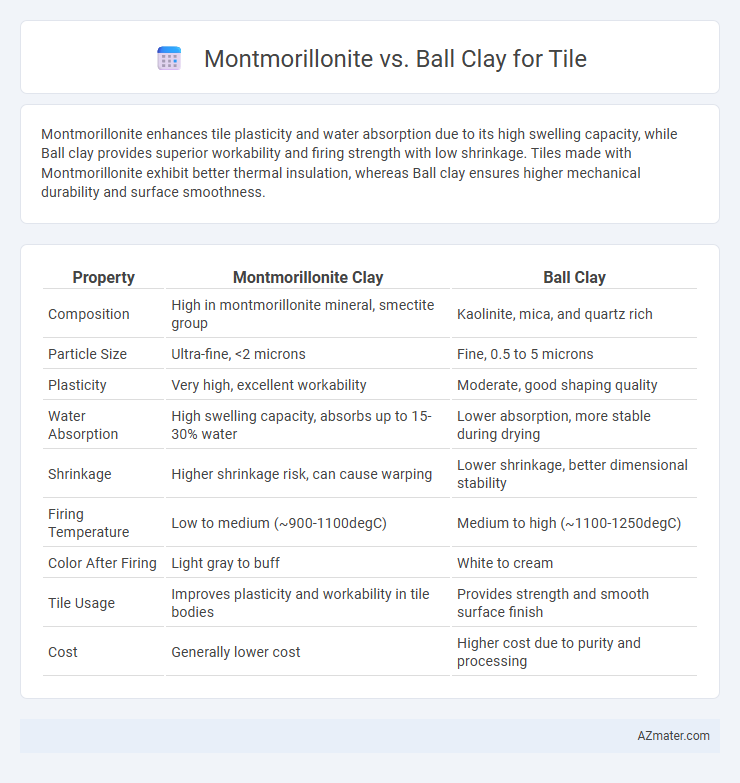Montmorillonite enhances tile plasticity and water absorption due to its high swelling capacity, while Ball clay provides superior workability and firing strength with low shrinkage. Tiles made with Montmorillonite exhibit better thermal insulation, whereas Ball clay ensures higher mechanical durability and surface smoothness.
Table of Comparison
| Property | Montmorillonite Clay | Ball Clay |
|---|---|---|
| Composition | High in montmorillonite mineral, smectite group | Kaolinite, mica, and quartz rich |
| Particle Size | Ultra-fine, <2 microns | Fine, 0.5 to 5 microns |
| Plasticity | Very high, excellent workability | Moderate, good shaping quality |
| Water Absorption | High swelling capacity, absorbs up to 15-30% water | Lower absorption, more stable during drying |
| Shrinkage | Higher shrinkage risk, can cause warping | Lower shrinkage, better dimensional stability |
| Firing Temperature | Low to medium (~900-1100degC) | Medium to high (~1100-1250degC) |
| Color After Firing | Light gray to buff | White to cream |
| Tile Usage | Improves plasticity and workability in tile bodies | Provides strength and smooth surface finish |
| Cost | Generally lower cost | Higher cost due to purity and processing |
Introduction to Montmorillonite and Ball Clay
Montmorillonite is a type of smectite clay mineral known for its high swelling capacity and excellent plasticity, making it ideal for enhancing the workability and flexibility of tile bodies. Ball clay, primarily composed of kaolinite, mica, and quartz, offers superior plasticity and strength, contributing to the durability and fine texture of ceramic tiles. Both clays are essential in tile manufacturing, with montmorillonite improving shrinkage control and ball clay providing structural integrity.
Chemical Composition Differences
Montmorillonite contains higher levels of montmorillonite clay minerals, rich in smectite group minerals with significant swelling capacity due to its layered silicate structure, primarily composed of silica, alumina, and exchangeable cations like magnesium and calcium. Ball clay predominantly consists of kaolinite with fine-grained particles, containing higher amounts of silica, alumina, and trace organic matter, contributing to plasticity but lacking the expansive properties of montmorillonite. The chemical distinction influences tile manufacturing by affecting plasticity, drying shrinkage, and firing behavior, where montmorillonite offers superior plasticity but higher shrinkage compared to ball clay's more stable shrinkage and refractory characteristics.
Physical Properties Comparison
Montmorillonite exhibits high plasticity and swelling capacity due to its layered silicate structure, making it ideal for enhancing tile workability and water retention. Ball clay features finer particle size and lower swelling but offers superior dry strength and firing characteristics, contributing to tile durability and surface smoothness. Selecting between the two depends on the desired balance between plasticity, shrinkage control, and final tile mechanical strength.
Plasticity and Workability in Tile Production
Montmorillonite offers high plasticity due to its swelling properties, enhancing workability and shaping precision in tile production. Ball clay also provides excellent plasticity but with finer particle size, enabling smoother surface finishes and reduced drying shrinkage. The choice depends on the balance between moldability and firing performance, with montmorillonite favored for flexible shaping and ball clay for consistent texture.
Firing Behavior and Temperature Ranges
Montmorillonite exhibits high plasticity and swells significantly when mixed with water, requiring lower firing temperatures typically between 1150degC and 1250degC to achieve vitrification in tile production. Ball clay, with fine particle size and moderate plasticity, fires within a broader temperature range of 1100degC to 1300degC, promoting better strength and surface finish in ceramic tiles. The lower melting point and flux content of montmorillonite make it ideal for tiles needing rapid densification, whereas ball clay's stable firing behavior supports durability and reduced warping.
Impact on Tile Strength and Durability
Montmorillonite enhances tile strength due to its high plasticity and swelling properties, which improve the clay body's cohesion and resistance to cracking during drying and firing. Ball clay contributes to tile durability by providing fine particle size and excellent plasticity, promoting better workability and a denser, less porous final product. Combining Montmorillonite and Ball clay in tile formulations optimizes mechanical strength and long-term durability, making tiles more resistant to wear, impact, and environmental stress.
Color and Appearance in Finished Tiles
Montmorillonite imparts a lighter, creamier color to finished tiles due to its high plasticity and fine particle size, resulting in a smoother surface and uniform texture. Ball clay produces tiles with a warmer, more beige to reddish hue, influenced by its higher iron content, and offers excellent workability for dense, durable tile bodies. The choice between Montmorillonite and Ball clay affects the tile's visual appeal by balancing color consistency with surface finish quality.
Common Applications in the Tile Industry
Montmorillonite is widely used in the tile industry for its excellent plasticity and water absorption properties, which enhance the molding and firing process of ceramic tiles. Ball clay, known for its fine particle size and high bonding strength, is commonly incorporated to improve the tile body's strength, plasticity, and surface smoothness. Both clays play critical roles in producing durable, defect-free tiles, with Montmorillonite favored for its swelling capacity and Ball clay valued for its consistency and workability in tile formulations.
Cost and Availability Considerations
Montmorillonite is generally more expensive than Ball clay due to its higher purity and specialized properties, affecting overall tile production costs. Ball clay offers a cost-effective alternative with widespread availability, making it a preferred choice for large-scale tile manufacturing. Availability of Ball clay deposits worldwide ensures consistent supply, whereas Montmorillonite sources are more limited and geographically constrained.
Choosing the Best Clay for Tile Manufacturing
Montmorillonite clay offers excellent plasticity and high expansion properties, making it ideal for tile formulations requiring enhanced workability and durability. Ball clay provides superior particle packing and strength, contributing to tile density and smooth surface finish. Selecting the best clay depends on balancing Montmorillonite's plasticity with Ball clay's bonding characteristics to achieve optimal tile performance and cost-efficiency.

Infographic: Montmorillonite vs Ball clay for Tile
 azmater.com
azmater.com